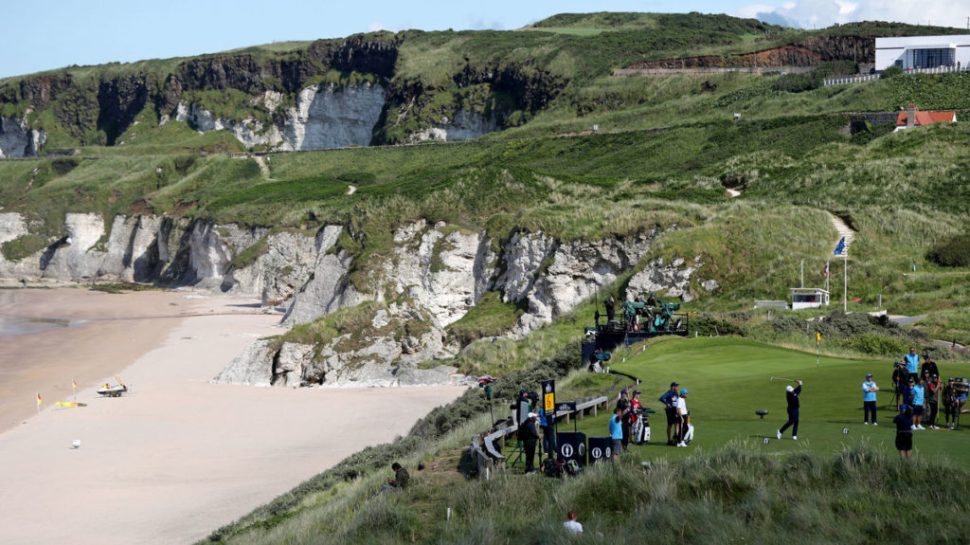PORTRUSH, Northern Ireland. There were a number of questions needing to be answered, when for only the second time in 68 years, golf’s oldest major championship ventured outside the predictable domains of Scotland and England respectively.
Those questions have now been answered — in an overwhelmingly positive manner.

Although the R&A was slow to bring Portrush into the fold the organization still does deserve credit for doing what seemed unlikely not that many years ago. Most notably through Peter Dawson, the R&A’s then chief executive officer for 16 years. When all these discussions were taking place. Dawson publicly played “hard to get” but credit his leadership in convincing others within the R&A that bringing The Open to Portrush was going to be a beneficial move.
The Open Championship has now added a 10th site to the limited rota of venues used for the event. Interestingly, the contract with the club calls for two additional Opens to be scheduled on or before 2040.
The rousing success of Portrush reminded me of the “risk” taken by the IUSGA back in 1986 when the famed Shinnecock Hills returned to the spotlight — a mere 90 years after having hosted the event’s second championship in 1896. Credit then Executive Director Frank Hannigan for pushing the USGA to see the merits of the famed eastern Long island layout even though there were clear hurdles needed to overcome. In the years to follow — Shinnecock Hills has now hosted five US Opens — with a sixth planned for ’26.

Royal Portrush has been known for quite some by golf’s cognoscenti for its stellar design, but staging a major championship is a far different matter. Those involved with Portrush did all of the early heavy lifting — staging other events — such as the Senior Open Championship six times. Having a continuous run of success with various Irish golfers including Graeme McDowell (2010 US Open), Rory McIlroy (2011 US Open) and Darren Clarke (2011 Open) as well as three past major wins by Padraig Harrington bolstered the case.
Credit is equally due to the tenacity of club secretary Wilma Erskine who doggedly believed an Open Championship could be successfully staged across the Irish Sea. Erskine painstakingly checked off the numerous boxes containing a myriad of details in order to keep the momentum going forward. As a member’s club it’s no small task to keep the egos in check and Erskine proved that the best man for the job is most certainly a woman. Her retirement from the position of club secretary at year’s end will clearly mean big shoes to fill.
One cannot minimize the excitement level showed by the Irish people. The event was a sellout with approximately 237,000 people attending and marked the second highest number of attendees only behind St. Andrews when hosting the 2000 Open.
The Dunluce Links is the handiwork of the famed Harry S. Colt but with the need to eliminate the previous 17th and 18th holes near to the clubhouse in order to locate the enormous Open village the task in creating two new holes was no small task. The R&A has been using the services of architect Martin Ebert for other Opens and he brilliantly conceived of the new additions located in the dunes setting courtesy of the sister Valley Course. Other touch-ups were done to the Colt classic and Ebert wisely made sure that all the key elements were tied together in a seamless manner. The story was quite rightly focused on the course itself.

The R&A also deserves immense credit in smartly setting up the test. There was nary any negative comments from the players and given the Jekyll and Hyde nature of links golf that’s no small achievement. Low scores were possible — witness Shane Lowry’s magical 63 in the 3rd round and there were several 65s — including one from Ulsterman Rory McIlroy in the 2nd round — although he failed to make the 36-hole cut despite a valiant attempt.
Shinnecock Hills is now widely seen as one of the three top US Open venues — along with Pebble Beach and Oakmont. Portrush is clearly gaining ground and frankly deserves to be mentioned with the likes of The Old Course at St. Andrews and Muirfield.
Early reports have already indicated Portrush is being seriously contemplated for the ’24 Open. Clearly, with the momentum from this year’s event — a quick return in five years would be unprecedented but most certainly deserved. In a parallel way — the USGA quickly returned to Shinnecock following the 1986 event — with follow-ups played in 1995 and 2004.
In the early discussions there was much concern expressed on how those attending would be able to handle the local logistics. Those situations were adroitly handled with many choosing rail service — most notably to/from Belfast. Credit the array of volunteers and the synergy displayed on a range of issues tied to the successful administration of any major event.
Most of all, Portrush will be remembered for the fact that an Irishman claimed the top prize. Seeing Shane Lowry applaud his fellow countrymen as he approached the final green showed the world the quality of Irish golf and its people.
The final major of the decade.
— PGA TOUR (@PGATOUR) July 22, 2019
Good night, Royal Portrush. 🌅 pic.twitter.com/r8lNgv00Ll
After the 1951 Open, Royal Portrush resided in the shadows for far too long. Much had to get done in those intervening years. That long absence came to a fitting ending with this year’s superlative Open Championship.
